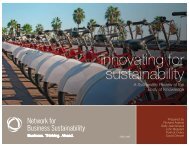embedding sustainability in organizational culture - Network for ...
embedding sustainability in organizational culture - Network for ...
embedding sustainability in organizational culture - Network for ...
Create successful ePaper yourself
Turn your PDF publications into a flip-book with our unique Google optimized e-Paper software.
Chapter 1: 4: Introduction Clarify<strong>in</strong>g expectations<br />
37<br />
In a study on corporate <strong>culture</strong>, Bourgault, Dion and Lemay (1993) found that<br />
monitor<strong>in</strong>g whether senior managers’ per<strong>for</strong>mance is aligned with <strong>organizational</strong><br />
goals is <strong>in</strong>tegral to <strong>embedd<strong>in</strong>g</strong> <strong>organizational</strong> values among their divisions.<br />
While we f<strong>in</strong>d empirical support <strong>for</strong> the need to monitor and track, more research<br />
needs to be done to understand how monitor<strong>in</strong>g and track<strong>in</strong>g shapes a <strong>culture</strong> of<br />
<strong>susta<strong>in</strong>ability</strong>.<br />
assessment: Weakly supported<br />
REpoRt: document <strong>susta<strong>in</strong>ability</strong> per<strong>for</strong>mance and progress<br />
• Implement a corporate environmental report<strong>in</strong>g system<br />
• Publish <strong>in</strong>ternal and external environmental, <strong>susta<strong>in</strong>ability</strong> or CSR<br />
reports<br />
• Report on <strong>susta<strong>in</strong>ability</strong> progress, address<strong>in</strong>g previously set goals<br />
• Report on future plans and commitments<br />
Susta<strong>in</strong>ability reports communicate an organization’s progress and future<br />
commitment toward <strong>susta<strong>in</strong>ability</strong>. They serve as a public record of an organization’s<br />
goals and encourage transparency and accountability. These reports also ma<strong>in</strong>ta<strong>in</strong><br />
dialogue with many stakeholders, <strong>in</strong>clud<strong>in</strong>g shareholders, customers, bus<strong>in</strong>ess<br />
partners, government, and employees throughout the organization (Maon et al.,<br />
2009).<br />
A company <strong>in</strong> Wei-Skillern’s study (2004) encouraged open dialogue by <strong>in</strong>vit<strong>in</strong>g<br />
feedback on its activities. This <strong>in</strong>itiative was so popular that a dedicated person was<br />
assigned to handle stakeholder responses. A report can also be used <strong>for</strong> <strong>in</strong>ternal<br />
purposes, such as establish<strong>in</strong>g commitments and hold<strong>in</strong>g departments publicly<br />
responsible. This can be an important driver of <strong>susta<strong>in</strong>ability</strong> per<strong>for</strong>mance (Ethical<br />
Corporation, 2009).<br />
Annandale et al. (2004) found that while <strong>in</strong>terview respondents acknowledged<br />
the positive impact of corporate environmental report<strong>in</strong>g on environmental<br />
per<strong>for</strong>mance, it was seen as primarily a public relations exercise, and had less<br />
impact <strong>in</strong> improv<strong>in</strong>g environmental awareness than environmental management<br />
systems.<br />
While these studies po<strong>in</strong>t to the potential <strong>for</strong> <strong>susta<strong>in</strong>ability</strong> report<strong>in</strong>g to shape<br />
<strong>culture</strong>, we found no studies that explicitly explore this theme. Given the substantive<br />
<strong>in</strong>vestments that organizations make <strong>in</strong> report<strong>in</strong>g, this is an area worthy of more<br />
exploration.<br />
assessment: proposed but not tested<br />
verify/audit<br />
This category <strong>in</strong>volves more <strong>for</strong>mal evaluations than the previous category<br />
(assess<strong>in</strong>g). Practices <strong>in</strong> this category exam<strong>in</strong>e an organization’s systems, processes,<br />
projects or products <strong>for</strong> reliability, accuracy, adherence to standards, and<br />
compliance. An audit will scrut<strong>in</strong>ize operations, systems and procedures to check<br />
whether they meet external or <strong>in</strong>ternal standards. This not only drives improvement,<br />
but also signals an organization’s read<strong>in</strong>ess and commitment to meet<strong>in</strong>g its<br />
obligations. An additional layer of scrut<strong>in</strong>y is ga<strong>in</strong>ed from third-party verification.<br />
audit: <strong>organizational</strong> members exam<strong>in</strong>e their own systems, processes,<br />
projects or products <strong>for</strong> reliability, accuracy, adherence to standards and<br />
compliance<br />
• Conduct regular <strong>in</strong>ternal audits of systems and processes<br />
• Create audit committees or departments<br />
• Ensure that the <strong>in</strong>ternal audit function reports to, or is represented<br />
on, the board of directors<br />
• Draw upon exist<strong>in</strong>g expertise <strong>in</strong> f<strong>in</strong>ancial and health and safety<br />
audit<strong>in</strong>g<br />
In order to move from a reactive state to a proactive state, an organization must<br />
set its own high standards <strong>for</strong> systems, processes and environmental impacts, and<br />
regularly check <strong>for</strong> adherence. Organizations can draw upon expertise with<strong>in</strong> their<br />
organization <strong>for</strong> f<strong>in</strong>ancial audit<strong>in</strong>g or health and safety audit<strong>in</strong>g to develop a robust<br />
system of <strong>susta<strong>in</strong>ability</strong> audits.<br />
Audit<strong>in</strong>g was seen by lead<strong>in</strong>g firms as important <strong>for</strong> achiev<strong>in</strong>g cont<strong>in</strong>uous<br />
improvement (Annandale et al., 2004) and as a process of assurance, to demonstrate<br />
the quality of per<strong>for</strong>mance aga<strong>in</strong>st stated objectives (Livesey & Kear<strong>in</strong>s, 2002).<br />
Internal audits can re<strong>in</strong><strong>for</strong>ce procedures, reveal lapses and spark new momentum<br />
<strong>for</strong> ensur<strong>in</strong>g <strong>susta<strong>in</strong>ability</strong> per<strong>for</strong>mance (Hagen, 2008).<br />
In their study on safety improvement, McCarthy and Blumenthal (2006) found that<br />
<strong>embedd<strong>in</strong>g</strong> a <strong>culture</strong> of safety improvement was assisted by the regular audit<strong>in</strong>g
















